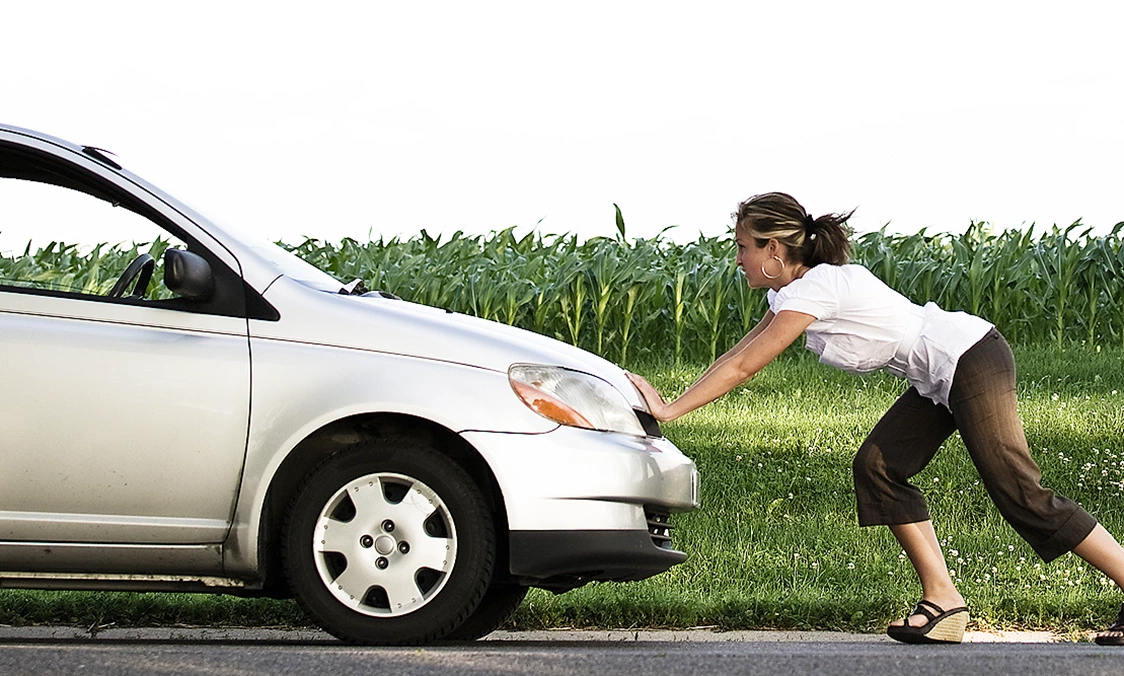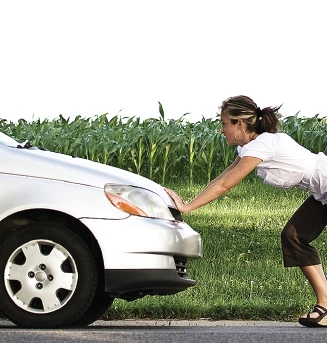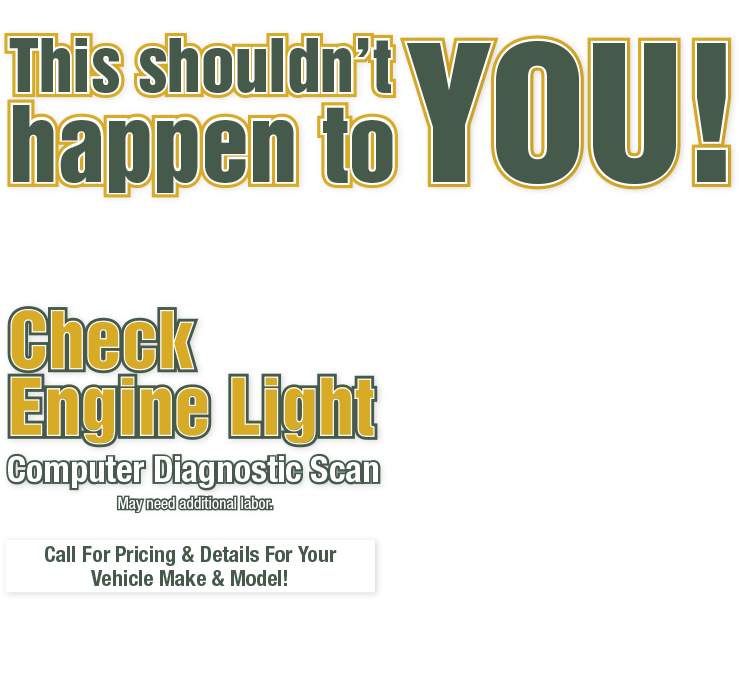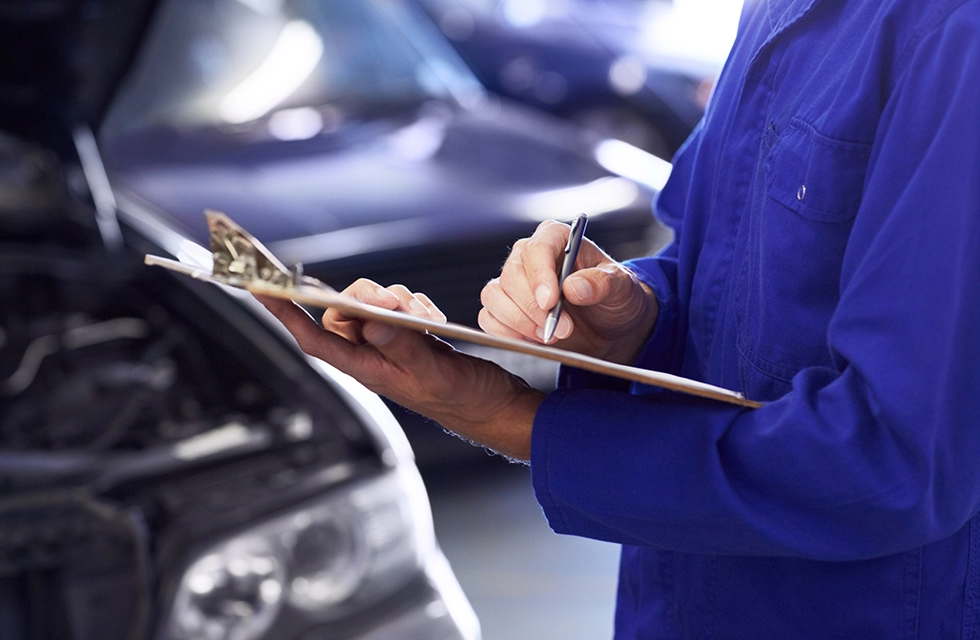-
How much air should I put in my tires?
Proper inflation is the single most important part of tire care. Check or adjust inflation every few months and always use the inflation recommended by the vehicle manufacturer. Checking air pressure should be standard procedure on any routine visit to your vehicle service center for oil services, tire rotations, or general maintenance and repair.
For do-it-yourselfers you can find this information in your owner's manual, posted on the edge of the driver's door, on a door post, in the center console, or on the inside of the glovebox door. Be sure to check inflation when tires are COLD: when the vehicle has been driven less than a mile or one hour or more after driving. Use a good quality tire gauge. And don't forget to check the spare!
-
Is it safe to repair a flat tire?
If a tire loses all or most of its air pressure, it must be removed from the wheel for a complete internal inspection to be sure it's not damaged. Tires that are run even short distances while flat are often damaged beyond repair. Most punctures nail holes, or cuts up to 1/4 inch which are confined to the tread may be satisfactorily repaired by trained personnel using industry-approved methods. Don't repair tires with tread punctures larger than 1/4 inch, or with any sidewall puncture. Also, never repair tires that are worn below 1/16 inch tread depth. Your Advisor and tire technician can advise you.
-
What is Road Hazard Protection?
Think of Road Hazard Protection as a replacement insurance policy on any un-repairable damage to your tire (excludes collision and deliberate destruction). Typical costs are minimal and offered only at the point of sale.
-
Do I have to replace my present tires with the same size tires?
Tires should always be replaced with the same size designation or approved options. Never choose a smaller size than those that came with the car. It is recommended that all tires be the same size, construction (radial, non-radial) and speed rating. If tires of different speed ratings are mounted on the vehicle, it is important to place the same size, type and speed ratings on the same axle.Tires of different size designations, constructions, and stages of wear can affect the vehicles handling and stability.
-
Should I rotate my tires?
The main purpose of regularly rotating tires is to achieve more uniform wear for all tires on the vehicle. It is recommended that you rotate your tires at least every 6,000 to 8,000 miles or uneven wear may develop. At strongly tire-oriented facilities this is a service typically done at no additional cost; along with free flat repairs, Nitrogen inflation, and an undercar inspection.
-
How important is wheel alignment?
It is very important! Having your wheels aligned helps in prolonging the life of your tires. Research indicates that the average car is driven about 12,000 miles per year. A car with toe alignment just 0.34 degrees (Just 0.17 inches) out of specification has dragged its tires sideways.
-
How often should I have my car aligned?
Vehicle manufacturers as a general rule recommend an annual alignment check. Unless there are obvious handling or wear problems this may not be necessary. As a general rule, have your vehicle aligned with every set of new tires, any suspension or steering part replacements, and at least every two years.
-
What should I do if I notice a vibration?
Vibration is an indication that your car has a problem. You should have your tires, steering system and suspension system checked to help determine the cause and correction of the vibration. If the problem is not corrected, the vibration could cause excessive tire and suspension wear.
-
Can I drive normally on my spare tire?
Many newer vehicles come equipped with a temporary spare, sometimes called a "donut". These tires are usually much smaller than the other tires on your car. It is important to realize that these spares have far more limitations than a typical tire, including speed and recommended driving distance. No more than 50mph and drive no further than 50 miles on the "donut" temporary spare.
-
What are the benefits to Nitrogen filled tires?
The single biggest reason for tire failure is lack of maintenance of tire pressure. In fact, 54 percent of all vehicles on the road have low tire pressure. Oxygen in compressed air can permeate the tire wall reducing tire pressure. With nitrogen, diffusion is 30 to 40 percent slower than oxygen. As a result, nitrogen maintains tire pressure longer than ambient air.
Maintaining tire pressure can boost fuel economy by as much as 6 percent. Nitrogen disperses heat more quickly than ambient air. By restraining the heat in the tire and reducing rolling resistance, you get better fuel economy. Longer tread life. With quicker heat dispersion, you get a cooler running tire which helps extend tread life and reduce tire failure. Nitrogen also prevents oxidation which can not only lead to tread separation and belt failure but, when combined with moisture, corrode rims. In fact, moisture can result in rust flakes that can fall into the valve stem, block the valve and cause under-pressurization. It can even cause the valve stem itself to rust. Slow chemical aging. Filling a tire with nitrogen also significantly slows the chemical aging process of the tire's rubber components. This leads to fewer catastrophic failures like blowouts. Slower aging lengthens tire core life, which yields extra retreads and lower fleet costs.
-
An illuminated light on my dash shows that I have a low tire. Can I just put air in it?
In many cases correcting the air pressure in your tires will extinguish the Tire Pressure Monitoring System (TPMS) warning light. Often seasonal temperature drops will lower tire air pressure a few pounds (a good case for Nitrogen – see 11 above) and trigger the TPMS warning light. In all cases where one or two particular tires are significantly lower than the others, or lower than the factory recommended pressure, a trained tire technician should examine the tire to determine the cause and examine the casing for signs of over stress. Some TPMS systems require special tools to access the vehicle computer. Advanced level tire technicians are trained and equipped for this technology.
-
With so many brand options and price differences why not just pick the cheapest tire. Is there really a difference?
The old adage: you get what you pay for is true in tire purchasing – somewhat! Since the introduction of the “radial tire” the assumption is that no significant changes have occurred in the world of tire building.
The facts are that major tire builders are spending tens of millions of dollars annually in research to improve their products and the reliability and performance of tires have taken a quantum leap forward. Research in the area of tread compounding polymers, rubber mixing methods, tread design, casing design and materials, build processes, and other research has resulted in a product that is far advanced from the tires we were driving on a decade ago. The discovery of Silica’s use in tread rubber compound alone has greatly influenced wear and adhesion characteristics of tires. Some of today’s tires can stop a car on a wet highway in distances unfathomable a decade ago. Tire builders strive to produce a product that balances production costs against safety, noise, ride quality, wear, handling, rolling resistance, and other attributes. Their cheapest products will not much focus on safety and other technologies that better tires have to offer. Conversely the higher priced lines often fall short of the best features. Knowledgeable Tire Sales Advisors can discuss test data and sort through the claims that manufacturers make regarding their products and help you make this important decision.
-
How often should I rotate my tires?
Your tires should be rotated every other oil change, or every 6000 miles. Neglecting to rotate tires is a major cause of premature tire wear.
-
Check out the dealer.
If you decide to purchase from a dealer, ask your friends, neighbors and others about their experiences with the dealer. Contact CAP for complaint history information for any dealer you are considering a purchase from.
-
What are the consequences of postponing maintenance?
Many parts on your vehicle are interrelated. Ignoring maintenance can lead to trouble: specific parts, or an entire system, can fail. Neglecting even simple routine maintenance, such as changing the oil or checking the coolant, can lead to poor fuel economy, unreliability, or costly breakdowns. It also may invalidate your warranty. Properly maintaining your vehicle is less expensive than repairs from negligence.
-
If I don't take my car to my car dealer for maintenance or repair will I void my warranty?
As a vehicle owner you should know about the Magnuson Moss Warranty Act. In 1975 the US Congress passed the Magnuson-Moss Warranty Act – a federal law that governs consumer product warranties. Among other things Congress wanted to ensure that consumers could get complete and straight forward information about warranty terms and conditions. In short the Magnuson-Moss Act gives you these rights.
Generally your vehicle manufacturer’s warranty cannot require you to return to your auto dealer for vehicle maintenance – or to use only the brand of replacement parts offered by that dealer.
By law your vehicle’s manufacturer’s warranty will stay in effect when you have regularly scheduled maintenance performed at a qualified facility that use appropriate parts and procedures.
-
My check engine or service engine soon light comes on. What should I do?
When you first start your car all the dashboard lights come on as a safety test. These lights will go off when the test is complete. If your light comes on later you need to have it checked by a competent technician familiar with modern diagnostic procedures. This could be a simple problem, but left alone it may result in an expensive repair. Don’t ignore this warning.
-
Why does my vehicle's maintenance schedule recommend so many fuel system services?
Modern engines have long abandoned carburetion with its many parts destined for failure in favor of simple and direct electronic injection of fuel. No longer are we shackled with the necessity of constant adjustment or repair. A properly maintained fuel delivery system today offers much improved reliability and efficiency than those systems of old.
Millions of cars today run at a level of efficiency considerably reduced, due to the high concentration of carbon deposits accumulated in the fuel injection system, intake valves, combustion chambers, oxygen sensor and catalytic converter. Carbon build-up clogs fuel filters, reduces fuel flow, distorts fuel spray patterns, limits fuel automation and decreases combustion efficiency.
Carbon build-up gradually robs your vehicle of performance and fuel economy, and may cause numerous problems such as engine malfunction, high emissions, excessive fuel consumption, loss of performance, rough idling and hard starts. Simply infusing an additive into a gas tank will not adequately decarbonizes injectors, cylinder heads, valves, intake plenums, exhaust emission sensors, and other critical components.
-
I have 100,000 mile spark plugs in my car. When will I need a tune-up?
In the traditional sense there is no such thing as a tune-up anymore. Carburetors and distributors with their myriad of parts destined to failure have been replaced with electronic injectors and electronic ignition systems. There is virtually little to wear out.
Aging Ignition wires and spark plugs may continue to function for 100,000 miles but not optimally. The car manufacturer’s boastful claim of 100,000 between tune-ups has little grounding in common sense, and is mostly a marketing ploy. At the price of gasoline these days even a three percent decrease in fuel efficiency is expensive, not to mention ecologically unfriendly. A fresh set of spark plugs any time over 50,000 miles will normally make a noticeable difference.
-
What are all of the chemicals and fluid flushes for? Are they really necessary?
Protecting the vital wear points of your vehicle with quality lubricants will vastly improve service life and will provide optimum efficiency. Today’s properly maintained vehicles with 100,000 miles no longer consume oil and break with high frequency. Chemistry has played an important role. The right chemicals can restore the ph balance in radiators so that acidity will not degrade hoses and internal metals in radiators and coolers. Other chemicals such as transmission flush chemicals along with pulse flush equipment rinse the oxidation from the valves and other internal workings of transmissions.
-
Is it really necessary to replace my timing belt at the recommended interval?
YES. The failure of a timing belt in many cars can result in major engine damage. The cost of repairing an engine with a broken timing belt is much greater than the cost of a timing belt replacement.
-
What does it mean if my "check engine" or "service engine soon" light comes on?
There are many sensors and computerized components that manage your vehicle’s engine performance and emissions. When one of these fails, the "check engine" light is illuminated. Although your car may seem to run fine, it is important to have the issue addressed to prevent long-term problems.
-
When should I change my spark plugs?
For maximum fuel economy and peak engine performance, your spark plugs should be replaced every 30 months or 30,000 miles, unless your vehicle is equipped with 100,000-mile platinum tipped spark plugs.
-
What is the difference between maintenance and safety?
Maintenance is done to prevent any future problems from occurring to the vehicle. Safety is to prevent any incident that would cause damage to the vehicle, to you or to the driver who is driving next to you.
-
With the change of the season and the temperatures, do I need to have my car checked?
It is a good idea to have your coolant checked to determine its freezing and boiling points to verify whether it needs to be changed. Have your air conditioner tested before the summer heats up, it is cheaper to fix before the season gets started.
-
I smell something in /around my car, what could it be?
• The smell of burned toast - a light, sharp odor - often signals an electrical short and burning insulation. To be safe, try not to drive the vehicle until the problem is diagnosed.
• The smell of rotten eggs - a continuous burning-sulfur smell - usually indicates a problem in the catalytic converter or other emission control devices. Don't delay diagnosis and repair. • A thick acrid odor usually means burning oil. Look for sign of a leak.
• The smell of gasoline vapors after a failed start may mean you have flooded the engine. Wait a few minutes before trying again. If the odor persists, chances are there's a leak in the fuel system - a potentially dangerous problem that needs immediate attention.
• Burring resin or an acrid chemical odor may signal overheated brakes or clutch. Check the parking brake. Stop and allow the brakes to cool after repeated hard braking on mountain roads. Light smoke coming from a wheel indicates a stuck brake. The vehicle should be towed for repair.
A sweet, steamy odor indicates a coolant leak. If the temperature gauge or warning light does not indicate overheating, drive carefully to the nearest service station, keeping an eye on your gauges. If the odor is accompanied by a hot, metallic scent and steam-from under the hood, your engine has overheated. Pull over immediately. Continued driving could cause severe engine damage. The vehicle should be towed for repair.
-
My car is making a terrible sound, what information will help?
Squeaks, squeals, rattles, rumbles, and other sounds provide valuable clues about problems and maintenance needs. Here are some common noises and their definitions.
Squeal - A shrill, sharp noise, usually related to engine speed.
Click - A slight sharp noise, related to either engine speed or vehicle speed.
Screech - A high-pitched, piercing metallic sound; usually occurs while the vehicle is in motion.
Rumble - a low-pitched rhythmic sound.
Ping - A high-pitched metallic tapping sound, related to engine speed.
Heavy Knock - A rhythmic pounding sound..
Clunk - A random thumping sound.
The more details you can provide us, the better chance of locating the problem quickly. Does the noise occur when the engine is cold or warm? Hot or cold outside, rainy or dry? Does the noise occur while driving or only when parked? These clues help the technician diagnose your problems faster, saving you time and money!
-
I hear an intermittent noise from the front of my car. Do I need to worry about it?
Every noise should be checked by a qualified technician. Use you best judgment, if it sounds bad, get it checked right away. Quick action on a problem can many times save big dollars.
-
How often should I change my oil?
Most car manufacturers say to change your oil every 7,500 miles unless you drive in severe conditions. Severe conditions are defined as dirty or dusty roads, extremely hot or cold climates, a lot of stop and go driving, taking long trips or if you tow a trailer. If you answer yes to any of the severe driving conditions, your vehicle falls into the severe conditions category, or the 3,000 mile oil change interval.
-
When should I get my oil changed?
You should get your oil changed every 3000 miles or as recommended in your vehicle’s owner’s manual.
-
What is that milky brown engine oil?
Milky brown engine oil is an indication of coolant in the oil. This can be caused by a blown head gasket (other gasket), a failed transmission cooler, or cracked casings. This condition is very serious and needs to be checked by a professional technician quickly.
-
What is synthetic motor oil?
Synthetic motor oils can be a good choice for high output, turbocharged or supercharged engines, vehicles that are used for towing (especially during hot weather), or vehicles that are operated in extremely cold or hot climates.
Synthetic motor oils, though several times more expensive than mineral-based motor oils, can improve fuel economy and provide longer intervals between changes. They also provide instant lubrication on start-up.
-
What is a Cabin Air Filter?
Cabin air filters filter the air that comes from the outside of a vehicle into the passenger compartment. They were originally designed to remove solid contaminants like dust and soot from circulating inside the vehicle. These filters can now also absorb gases and odors. Cabin air filters may also be known as passenger compartment filters, pollen filters, or dust filters.
-
When did Cabin Air Filters come into being?
Cabin air filters first appeared in European vehicles in the mid-1980's. They began appearing in North American vehicles in 1994.
-
Is a Cabin Air Filter the same as an engine intake filter?
While most cabin air filters look like simple panel filters that are used to filter air to the engine, they are much more technologically advanced and contain an entirely different filtering media. Basically, engine intake filters protect engine components, whereas cabin air filters protect your lungs.
-
Why are Cabin Air Filters important?
Air quality is becoming a major concern for many people - outdoors, in our homes, and now even in our automobiles. An estimated 50 million Americans suffer from hay fever and other allergy-related problems.
-
Where are Cabin Air Filters located?
Cabin air filters are typically located behind a vehicle's dashboard, or behind the glove box. Others may be located in the engine compartment, typically in the cowl area.
-
How often should they be replaced?
Vehicle manufacturer recommendations may vary, but the general guideline for replacing cabin air filters is every 12,000 to 15,000 miles, or at least once a year.
-
What happens if they are not replaced at the recommended interval?
In addition to the possibility of unpleasant odors, filters that have been left in service for over 20,000 miles can result in decreased heating and air conditioning performance caused by restricted air flow through the cabin air filter.









